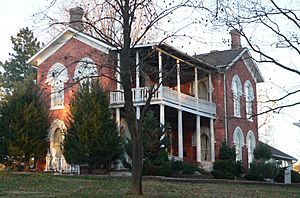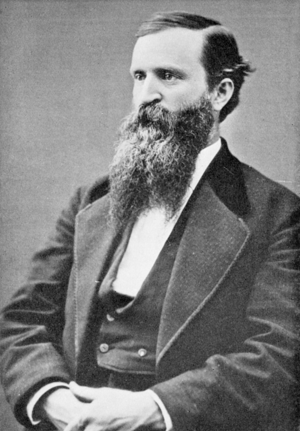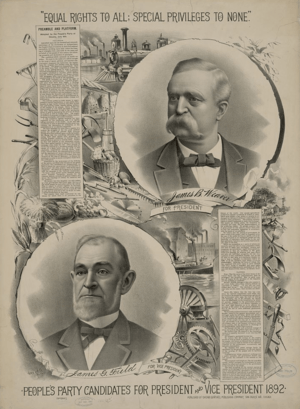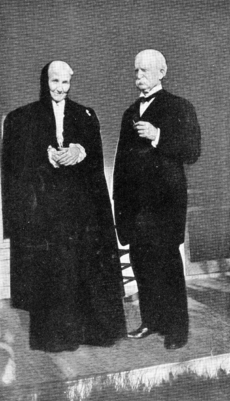James B. Weaver facts for kids
Quick facts for kids
James Weaver
|
|
|---|---|
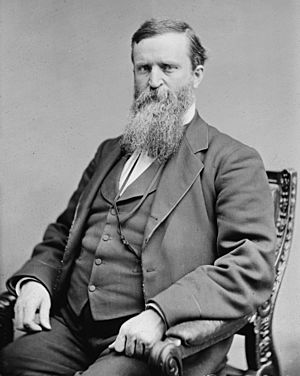 |
|
| Member of the U.S. House of Representatives from Iowa's 6th district |
|
| In office March 4, 1885 – March 3, 1889 |
|
| Preceded by | John C. Cook |
| Succeeded by | John F. Lacey |
| In office March 4, 1879 – March 3, 1881 |
|
| Preceded by | Ezekiel S. Sampson |
| Succeeded by | Marsena E. Cutts |
| Personal details | |
| Born |
James Baird Weaver
June 12, 1833 Dayton, Ohio, U.S. |
| Died | February 6, 1912 (aged 78) Des Moines, Iowa, U.S. |
| Political party | Republican (until 1876) Greenback (1877–1889) Populist (1890–1908) Democratic (1908–1912) |
| Spouse | Clarrisa Vinson |
| Education | University of Cincinnati (LLB) |
| Signature | |
| Military service | |
| Allegiance | |
| Branch/service | Union Army |
| Years of service | 1861–1864 |
| Rank | |
| Commands | 2nd Iowa Volunteer Infantry Regiment |
| Battles/wars | American Civil War |
James Baird Weaver (born June 12, 1833 – died February 6, 1912) was an important American politician. He served in the United States House of Representatives, which is part of the U.S. Congress. He also ran for President of the United States twice.
Weaver was born in Ohio but moved to Iowa as a child. His family settled on new land. He became interested in politics early on, fighting for the rights of farmers and workers. He changed political parties several times to support the ideas he believed in. After fighting in the American Civil War, he returned to Iowa. He later joined the Greenback Party, which wanted to increase the amount of money in circulation and control big businesses.
Contents
- James Weaver's Early Life
- Weaver's Role in the Civil War
- Weaver's Republican Political Career
- Joining the Greenback Party
- Weaver's Time in Congress
- Presidential Campaign of 1880
- Seeking Office and Promoting the Party
- Return to Congress and New Issues
- Farmers' Alliance and the Populist Party
- Presidential Campaign of 1892
- Later Years and Legacy
- Images for kids
- See also
James Weaver's Early Life
James Baird Weaver was born in Dayton, Ohio, on June 12, 1833. He was one of thirteen children. His father was a farmer. In 1835, his family moved to a farm in Michigan. In 1842, they moved again to the Iowa Territory. They settled on land in Davis County.
His father, Abram Weaver, was a Democrat and involved in local politics. James Weaver got his first job delivering mail. Later, he started studying law. In 1855, he went to Cincinnati Law School. After finishing school in 1856, he became a lawyer in Iowa.
Joining the Republican Party
By 1857, Weaver left the Democratic party. He joined the new Republican Party. This party was against slavery spreading to new areas. In 1858, he gave speeches for Republican candidates. That summer, he married Clarrisa (Clara) Vinson. They had eight children together. Weaver continued to be active in Republican politics. He supported Abraham Lincoln in the 1860 election. When Lincoln won, Southern states left the Union, and the American Civil War began.
Weaver's Role in the Civil War
After the war started, James Weaver joined the Union Army. He became a first lieutenant in the 2nd Iowa Volunteer Infantry Regiment. His unit went to Missouri in June 1861. They helped protect railroad lines.
Key Battles and Promotions
Weaver's first major battle was at Fort Donelson in Tennessee in February 1862. He was wounded in the arm. This was an important Union victory. Next, his unit fought in the Battle of Shiloh. This battle was very bloody, with many soldiers killed or wounded. It showed that the war would be long and difficult.
After Shiloh, Weaver was promoted to major. He fought bravely in the Second Battle of Corinth. His courage led to another promotion, this time to colonel. His unit then served in Mississippi and Tennessee. They later joined William Tecumseh Sherman's march through Georgia. Weaver's time in the army ended in May 1864. After the war, he was promoted to brevet brigadier general.
Weaver's Republican Political Career
After the war, Weaver became an editor for a Republican newspaper. In 1866, he was elected district attorney. In 1867, he got a good job as an assessor for the government. This job paid well. He also became involved in the Methodist Church. He supported the idea of banning alcohol. By 1877, he had seven children and a successful life. He built a large new home for his family.
Seeking Higher Office
Weaver wanted to represent Iowa's 6th congressional district in the U.S. House of Representatives in 1874. However, he lost the nomination by one vote. Many in his party did not like his strong support for banning alcohol. He then tried to become governor of Iowa in 1875. He campaigned hard, supporting alcohol bans and controlling railroad prices. But he lost this nomination too. He was also defeated in a state Senate election.
Joining the Greenback Party
After his losses, Weaver became unhappy with the Republican Party. In 1876, he went to a meeting of the new Greenback Party. This party formed because of an economic downturn. During the Civil War, the government printed "greenbacks," which were paper money not backed by gold. After the war, many wanted to switch back to money backed by gold. But Greenbackers wanted more paper money to help farmers and people in debt. They also supported an eight-hour workday and laws against child labor.
In 1877, Weaver officially joined the Greenback Party. He gave many speeches for his new party. He became a well-known supporter of the Greenback cause.
Weaver's Time in Congress
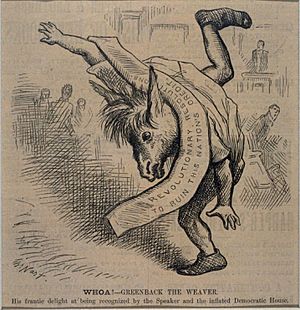
In May 1878, Weaver was nominated by the Greenback Party to run for the House of Representatives. Democrats in his district decided to support him. This was their best chance to defeat the Republican candidate. Weaver won the election and went to Congress in March 1879. He was one of thirteen Greenbackers in the House.
Fighting for Monetary Reform
Weaver gave his first speech in April 1879. He talked about the Greenback platform. He wanted to increase the money supply by allowing the unlimited coinage of silver. This idea was not popular with many in Congress.
In 1880, Weaver tried to introduce a resolution. It said the government, not banks, should control the money supply. The Speaker of the House, Samuel J. Randall, tried to stop him. But after some effort, Weaver was allowed to speak. Even though his resolution was defeated, he brought the issue of money to national attention.
Presidential Campaign of 1880
By 1879, the Greenback Party had split. Weaver stayed with the main party. His work in Congress made him a leading candidate for president. In June 1880, the Greenback convention nominated Weaver for president.
Weaver decided to campaign himself, which was unusual then. He traveled across the South, hoping to gain support. He spoke about including all races, but this led to protests in the South. He also campaigned in the North.
In the election, Weaver received about 306,000 votes. He did not win any electoral votes. This was about 3% of the total votes. While it was an improvement for the Greenback Party, it was less than Weaver had hoped for.
Seeking Office and Promoting the Party
After the election, Weaver returned to Congress. He proposed a change to the Constitution to allow people to directly elect Senators. This idea did not pass. After his term ended, he continued to travel and promote the Greenback Party. He even bought a newspaper to help spread their message.
In 1882, Weaver ran for his old House seat again. But this time, Democrats and Greenbackers ran separately. Weaver lost. In 1883, he ran for governor of Iowa but lost again. In 1884, he ran for the House once more, this time with Democratic support. He won by a very small margin.
Return to Congress and New Issues
When Weaver returned to Congress in 1885, he was the only Greenback member. He focused on money, finance, and the relationship between workers and business owners.
Supporting Workers and Farmers
In 1885, he suggested creating a Department of Labor. He believed it would help solve problems between workers and management. He thought that hard-money policies were causing problems for workers. He also supported the creation of the Interstate Commerce Commission to regulate railroads.
Weaver also spoke up for white settlers who wanted land in Indian Territory. After the Civil War, some Native American tribes had to give up land to the government. Settlers believed this land should be open for them to claim. Weaver supported these settlers, seeing it as a fight between poor farmers and wealthy cattle owners. He proposed a bill to create a new Oklahoma Territory. His bill did not pass at first.
Continuing the Fight for Land
Weaver kept pushing his bill. He wanted Indian reservations to be divided into homesteads for Native Americans. The remaining land would be open for white settlement. His bill was rejected again. However, a compromise bill was approved that opened some lands to settlement.
Weaver was re-elected to the House in 1886. In 1887, Congress passed the Dawes Act. This law allowed the president to break up tribal governments and reservations. Weaver continued to push for opening western Indian Territory to white settlement. His bill finally passed in 1889, and President Cleveland signed it into law.
Farmers' Alliance and the Populist Party
In 1889, a "land rush" began for the new lands in Oklahoma. Weaver went there, hoping to relocate. He even tried to claim land, but his claim was denied. He returned to Iowa in 1890.
Weaver and his wife moved to Colfax. He continued to promote the ideas of the Greenback and Union Labor parties, which had ended. Many farmers and workers felt their economic situation was getting worse. Many farmers joined the Farmers' Alliance. This group wanted to promote soft-money ideas.
In 1890, the Alliance created a platform called the Ocala Demands. It called for more money in circulation, government control of railroads, an income tax, and direct election of senators. Weaver supported these ideas. In 1891, many Alliance members decided to form a new political party.
Presidential Campaign of 1892
In 1892, Weaver accepted the decision to form the new People's Party, also known as the Populist Party. He wrote a book called A Call to Action, explaining the party's ideas. In July 1892, the Populist convention nominated Weaver for president. His running mate was James G. Field.
The Populist platform was very ambitious. It called for a graduated income tax, government ownership of railroads and telegraphs, and unlimited coinage of silver. Weaver was confident the new party would do well. He traveled across the country, giving speeches. He tried to get support from both white and black farmers in the South.
On election day, Weaver did not win. However, he had the best performance of any third-party candidate since the Civil War. He won over one million votes, which was 8.5% of the total. He won the electoral votes of Colorado, Idaho, Kansas, and Nevada, plus two votes from North Dakota and Oregon. He saw this as a "surprising success."
Later Years and Legacy
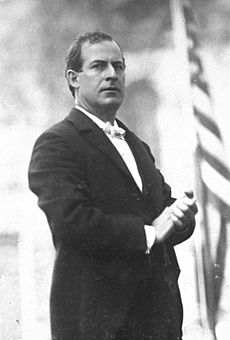
After the election, Weaver continued to support the idea of free silver. In 1893, an economic crisis hit the country. Weaver believed his ideas were more important than any single party. In 1896, he supported William Jennings Bryan, a Democrat who also believed in free silver. Bryan lost the election.
Weaver ran for his old House seat one last time but lost. In 1900, he supported Bryan again, but Bryan lost to McKinley. In 1901, Weaver was elected mayor of his hometown, Colfax, Iowa. He served until 1903.
Weaver's Final Years
Weaver became a Democrat and supported Bryan's third presidential campaign in 1908, which also failed. In 1908, James and Clara Weaver celebrated their 50th wedding anniversary. He wrote a history of Jasper County, Iowa, which was published in 1912.
James Weaver died on February 6, 1912, from heart failure. He was buried in Woodland Cemetery in Des Moines. Many of his political goals, like the direct election of Senators and a graduated income tax, became law after his death. Historians say Weaver helped start important conversations in American politics that led to these changes.
Images for kids
See also
 In Spanish: James B. Weaver para niños
In Spanish: James B. Weaver para niños



